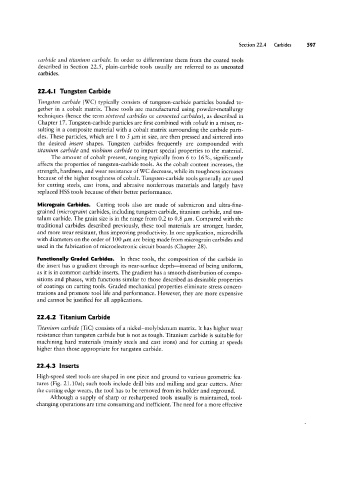Page 616 - 04. Subyek Engineering Materials - Manufacturing, Engineering and Technology SI 6th Edition - Serope Kalpakjian, Stephen Schmid (2009)
P. 616
Section 22 4 Carb|des
carbide and titanium carbide. In order to differentiate them from the coated tools
described in Section 22.5, plain-carbide tools usually are referred to as uncoated
carbides.
22.4.l Tungsten Carbide
Tungsten carbide (WC) typically consists of tungsten-carbide particles bonded to-
gether in a cobalt matrix. These tools are manufactured using powder-metallurgy
techniques (hence the term sintered carbides or cemented carbides), as described in
Chapter 17. Tungsten-carbide particles are first combined with cobalt in a mixer, re-
sulting in a composite material with a cobalt matrix surrounding the carbide parti-
cles. These particles, which are 1 to 5 /im in size, are then pressed and sintered into
the desired insert shapes. Tungsten carbides frequently are compounded with
titanium carbide and niobium carbide to impart special properties to the material.
The amount of cobalt present, ranging typically from 6 to 16%, significantly
affects the properties of tungsten-carbide tools. As the cobalt content increases, the
strength, hardness, and wear resistance of WC decrease, while its toughness increases
because of the higher toughness of cobalt. Tungsten-carbide tools generally are used
for cutting steels, cast irons, and abrasive nonferrous materials and largely have
replaced HSS tools because of their better performance.
Micrograin Carbides. Cutting tools also are made of submicron and ultra-fine-
grained (micrograin) carbides, including tungsten carbide, titanium carbide, and tan-
talum carbide. The grain size is in the range from 0.2 to 0.8 /im. Compared with the
traditional carbides described previously, these tool materials are stronger, harder,
and more Wear resistant, thus improving productivity. In one application, microdrills
with diameters on the order of 100 /.tm are being made from micrograin carbides and
used in the fabrication of microelectronic circuit boards (Chapter 28).
Functionally Graded Carbides. In these tools, the composition of the carbide in
the insert has a gradient through its near-surface depth-instead of being uniform,
as it is in common carbide inserts. The gradient has a smooth distribution of compo-
sitions and phases, with functions similar to those described as desirable properties
of coatings on cutting tools. Graded mechanical properties eliminate stress concen-
trations and promote tool life and performance. However, they are more expensive
and cannot be justified for all applications.
22.4.2 Titanium Carbide
Titanium carbide (TiC) consists of a nickel-molybdenum matrix. It has higher Wear
resistance than tungsten carbide but is not as tough. Titanium carbide is suitable for
machining hard materials (mainly steels and cast irons) and for cutting at speeds
higher than those appropriate for tungsten carbide.
22.4.3 Inserts
High-speed steel tools are shaped in one piece and ground to various geometric fea-
tures (Fig. 21.10a); such tools include drill bits and milling and gear cutters. After
the cutting edge Wears, the tool has to be removed from its holder and reground.
Although a supply of sharp or resharpened tools usually is maintained, tool-
changing operations are time consuming and inefficient. The need for a more effective

